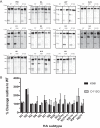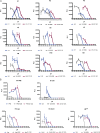Influenza hemagglutinin (HA) stem region mutations that stabilize or destabilize the structure of multiple HA subtypes
- PMID: 25653452
- PMCID: PMC4442347
- DOI: 10.1128/JVI.00057-15
Influenza hemagglutinin (HA) stem region mutations that stabilize or destabilize the structure of multiple HA subtypes
Abstract
Influenza A viruses enter host cells through endosomes, where acidification induces irreversible conformational changes of the viral hemagglutinin (HA) that drive the membrane fusion process. The prefusion conformation of the HA is metastable, and the pH of fusion can vary significantly among HA strains and subtypes. Furthermore, an accumulating body of evidence implicates HA stability properties as partial determinants of influenza host range, transmission phenotype, and pathogenic potential. Although previous studies have identified HA mutations that can affect HA stability, these have been limited to a small selection of HA strains and subtypes. Here we report a mutational analysis of HA stability utilizing a panel of expressed HAs representing a broad range of HA subtypes and strains, including avian representatives across the phylogenetic spectrum and several human strains. We focused on two highly conserved residues in the HA stem region: HA2 position 58, located at the membrane distal tip of the short helix of the hairpin loop structure, and HA2 position 112, located in the long helix in proximity to the fusion peptide. We demonstrate that a K58I mutation confers an acid-stable phenotype for nearly all HAs examined, whereas a D112G mutation consistently leads to elevated fusion pH. The results enhance our understanding of HA stability across multiple subtypes and provide an additional tool for risk assessment for circulating strains that may have other hallmarks of human adaptation. Furthermore, the K58I mutants, in particular, may be of interest for potential use in the development of vaccines with improved stability profiles.
Importance: The influenza A hemagglutinin glycoprotein (HA) mediates the receptor binding and membrane fusion functions that are essential for virus entry into host cells. While receptor binding has long been recognized for its role in host species specificity and transmission, membrane fusion and associated properties of HA stability have only recently been appreciated as potential determinants. We show here that mutations can be introduced at highly conserved positions to stabilize or destabilize the HA structure of multiple HA subtypes, expanding our knowledge base for this important phenotype. The practical implications of these findings extend to the field of vaccine design, since the HA mutations characterized here could potentially be utilized across a broad spectrum of influenza virus subtypes to improve the stability of vaccine strains or components.
Copyright © 2015, American Society for Microbiology. All Rights Reserved.
Figures






Similar articles
-
Intermonomer Interactions in Hemagglutinin Subunits HA1 and HA2 Affecting Hemagglutinin Stability and Influenza Virus Infectivity.J Virol. 2015 Oct;89(20):10602-11. doi: 10.1128/JVI.00939-15. Epub 2015 Aug 12. J Virol. 2015. PMID: 26269180 Free PMC article.
-
Receptor binding and pH stability - how influenza A virus hemagglutinin affects host-specific virus infection.Biochim Biophys Acta. 2014 Apr;1838(4):1153-68. doi: 10.1016/j.bbamem.2013.10.004. Epub 2013 Oct 24. Biochim Biophys Acta. 2014. PMID: 24161712 Review.
-
Amino acid residues in the fusion peptide pocket regulate the pH of activation of the H5N1 influenza virus hemagglutinin protein.J Virol. 2009 Apr;83(8):3568-80. doi: 10.1128/JVI.02238-08. Epub 2009 Feb 4. J Virol. 2009. PMID: 19193808 Free PMC article.
-
Influenza HA subtypes demonstrate divergent phenotypes for cleavage activation and pH of fusion: implications for host range and adaptation.PLoS Pathog. 2013 Feb;9(2):e1003151. doi: 10.1371/journal.ppat.1003151. Epub 2013 Feb 14. PLoS Pathog. 2013. PMID: 23459660 Free PMC article.
-
Receptor binding and membrane fusion in virus entry: the influenza hemagglutinin.Annu Rev Biochem. 2000;69:531-69. doi: 10.1146/annurev.biochem.69.1.531. Annu Rev Biochem. 2000. PMID: 10966468 Review.
Cited by
-
Age-Associated Changes in Recombinant H5 Highly Pathogenic and Low Pathogenic Avian Influenza Hemagglutinin Tissue Binding in Domestic Poultry Species.Animals (Basel). 2021 Jul 28;11(8):2223. doi: 10.3390/ani11082223. Animals (Basel). 2021. PMID: 34438681 Free PMC article.
-
Hemagglutinin Stability and Its Impact on Influenza A Virus Infectivity, Pathogenicity, and Transmissibility in Avians, Mice, Swine, Seals, Ferrets, and Humans.Viruses. 2021 Apr 24;13(5):746. doi: 10.3390/v13050746. Viruses. 2021. PMID: 33923198 Free PMC article. Review.
-
Raman signatures of type A and B influenza viruses: molecular origin of the "catch and kill" inactivation mechanism mediated by micrometric silicon nitride powder.RSC Chem Biol. 2025 Jan 22;6(2):182-208. doi: 10.1039/d4cb00237g. eCollection 2025 Feb 5. RSC Chem Biol. 2025. PMID: 39850321 Free PMC article.
-
Molecular Dynamics Investigation of the Influenza Hemagglutinin Conformational Changes in Acidic pH.J Phys Chem B. 2024 Nov 14;128(45):11151-11163. doi: 10.1021/acs.jpcb.4c04607. Epub 2024 Nov 4. J Phys Chem B. 2024. PMID: 39497238 Free PMC article.
-
Modulation of the pH Stability of Influenza Virus Hemagglutinin: A Host Cell Adaptation Strategy.Biophys J. 2016 Jun 7;110(11):2293-2301. doi: 10.1016/j.bpj.2016.04.035. Biophys J. 2016. PMID: 27276248 Free PMC article. Review.
References
-
- Gao R, Cao B, Hu Y, Feng Z, Wang D, Hu W, Chen J, Jie Z, Qiu H, Xu K, Xu X, Lu H, Zhu W, Gao Z, Xiang N, Shen Y, He Z, Gu Y, Zhang Z, Yang Y, Zhao X, Zhou L, Li X, Zou S, Zhang Y, Li X, Yang L, Guo J, Dong J, Li Q, Dong L, Zhu Y, Bai T, Wang S, Hao P, Yang W, Zhang Y, Han J, Yu H, Li D, Gao GF, Wu G, Wang Y, Yuan Z, Shu Y. 2013. Human infection with a novel avian-origin influenza A (H7N9) virus. N Engl J Med 368:1888–1897. doi:10.1056/NEJMoa1304459. - DOI - PubMed
Publication types
MeSH terms
Substances
Grants and funding
LinkOut - more resources
Full Text Sources
Other Literature Sources
Research Materials
Miscellaneous

